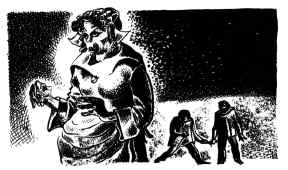Werewolves
There are a number of cultures which have were-creatures in thier mythology, usually involving large predators that hunt by night. Often the were-creatures takes the form of the most dangerous animal found in the area. India has weretigers, Africa has wereleopards, but the most famous of all are the werewolves of medieval Europe.
 The term "were" is from the old english word "wer" meaning man, Thus, werewolves , man-wolves, are half human and half animal.
The term "were" is from the old english word "wer" meaning man, Thus, werewolves , man-wolves, are half human and half animal.
References to wolf-men arose in Europe at around the time of Christ. In book Ten of Homer's Odysseus , the grandfather of the hero Odysseus is named Autolykos, meaning "he who is wolf." The people of Arcadia believed some members of thier culture had the ability to turn themselves into wolves. If they tasted human flesh during the transformation they were doomed to live out their lives as wild beasts unless they abstained from human flesh for nine years. The Roman poet Virgil wrote in the first century B.C about a sorcerer who took poisonous herbs to turn himself into a werewolf.
Werewolves were believed to have two origins, voluntary and involuntary.
Many voluntary werewolves were believed to be people who had made a pact with the devil. most werewolf tales describe men who turned into werewolves at night, when they devoured people and animals, and then returned to human form at daybreak. Night was a time of the devil.
Involuntary werewolves were those whose actions had inadvertently caused a horrible transformation. Persons born on Christmas Eve were often thought to be werewolves. In Sicily, a child conceived during a new moon was thought sure to grow up to be a werewolf. German folk tales told of a mountain brook whose waters turned humans into werewolves.
Tales in Serbia created werewolves from people who drank water collected in wolf footprints
People with slanted eyebrows were also automatically assumed to be wolfmen. In Greece, all epileptics were thought to be werewolves.
Some werewolves were believed to be sinners transformed by god for thier actions. Certain saints were thought to have the power to change sinners in to werewolves. In Armenia, it was believed that an adulterous woman would be visited by the devil, who would bring her a wolf skin to wear. To pay for her sins, she had to wear the skin for seven years before she could return to human form.
Surprisingly, even today there are those who still believe in werewolves. One study showed that eighty percent of Russian farmers surveyed believed in werewolves, proving that the negative imagery associated with wolves still lives
Click here to read a Werewolf Legend.
